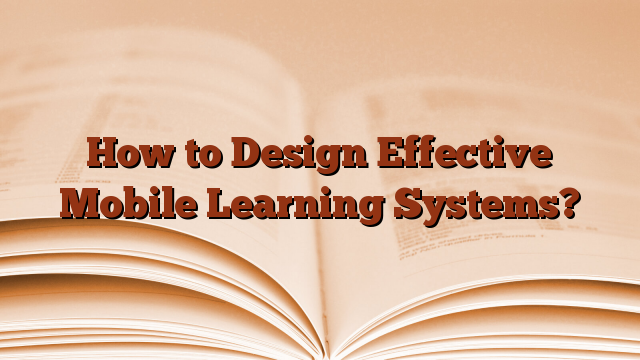Mobile learning is essentially based on technological progress in the field of information technology and communication. However, in order to make the state-of-the-art mobile devices usable for learning purposes, there needs to be greater understanding between different stakeholders, viz. the content providers, device manufacturers and application developers, and the end users.
“Begin and be aware of the endsaid Stephen R. Covey. The effectiveness of any mobile learning program depends on its planning premise. The ideas developed here are paradigmatic for any mobile learning scenario.
I. Paint the big picture: For end-user acceptance of mobile learning mode, always project the value. For example, an employee or student may need to travel and attend a weekend class or stay extra hours if they ignore the mobile option. Effectively communicate the cost versus time benefits and limitations of using traditional learning methods.
II. Provide a simple and intuitive user experience: Develop a “current technology vs. end-user capability matrix”. This requires continuous research on the leading mobile platforms – iPhone, Blackberry and Android. This sets the stage for content development with scalability across popular mobile platforms. What Bill Gates said regardless of context is true here; the barrier to change is not uncaring; it’s too much complexity.
III. Bridge the knowledge gap: One of the barriers to mobile learning is the gap that a learner faces between their current level of knowledge and the higher level they want to achieve. Design the content based on the average knowledge level of the intended learners. Provide additional links in the modules that provide basic knowledge on the subject to the end user who may need it.
IV The first impression is the best: Always aim for maximum positive impact on the end user when delivering content for the first time. In the first phase of learning, avoid ambiguous images or confusing topics. Stimulate interest by introducing easy-to-understand concepts with familiar access methods. Complex issues can wait until sufficient familiarity is achieved.
v. There is more than one way to skin a cat: The learning approach varies from person to person. Always develop alternative modules through which knowledge can be conveyed to different personalities. Provide plenty of leeway in assessment methods and introduce innovative recapitulation techniques.
VI. Provide easy feedback options: “Procrastination is the thief of time‘ said Edward Young. Many learners have an inherent reluctance to communicate their learning difficulties; some are good at verbal communication, others at writing, and some are more comfortable interacting with a peer group than with the one higher in the hierarchy. A good design should offer multiple feedback mechanisms, including the creation of peer group networks.
vii Haste makes waste: While delivering content too quickly can leave many behind, too slow a pace can hamper the pace of learning. Maintain a rhythm of delivery and evaluation based on focus group interview feedback. While excessive delays can impact overall learning goals, unresolved learning difficulties increase dropout rates and render the system ineffective.
The time has come for players to make capture points in the mobile learning Arena and the The early bird catches the worm. Any ill-conceived initiative can cast a shadow over the credibility of this innovative way of mobile learning.
Thanks to Vinod Subramani | #Design #Effective #Mobile #Learning #Systems

Leave a Reply